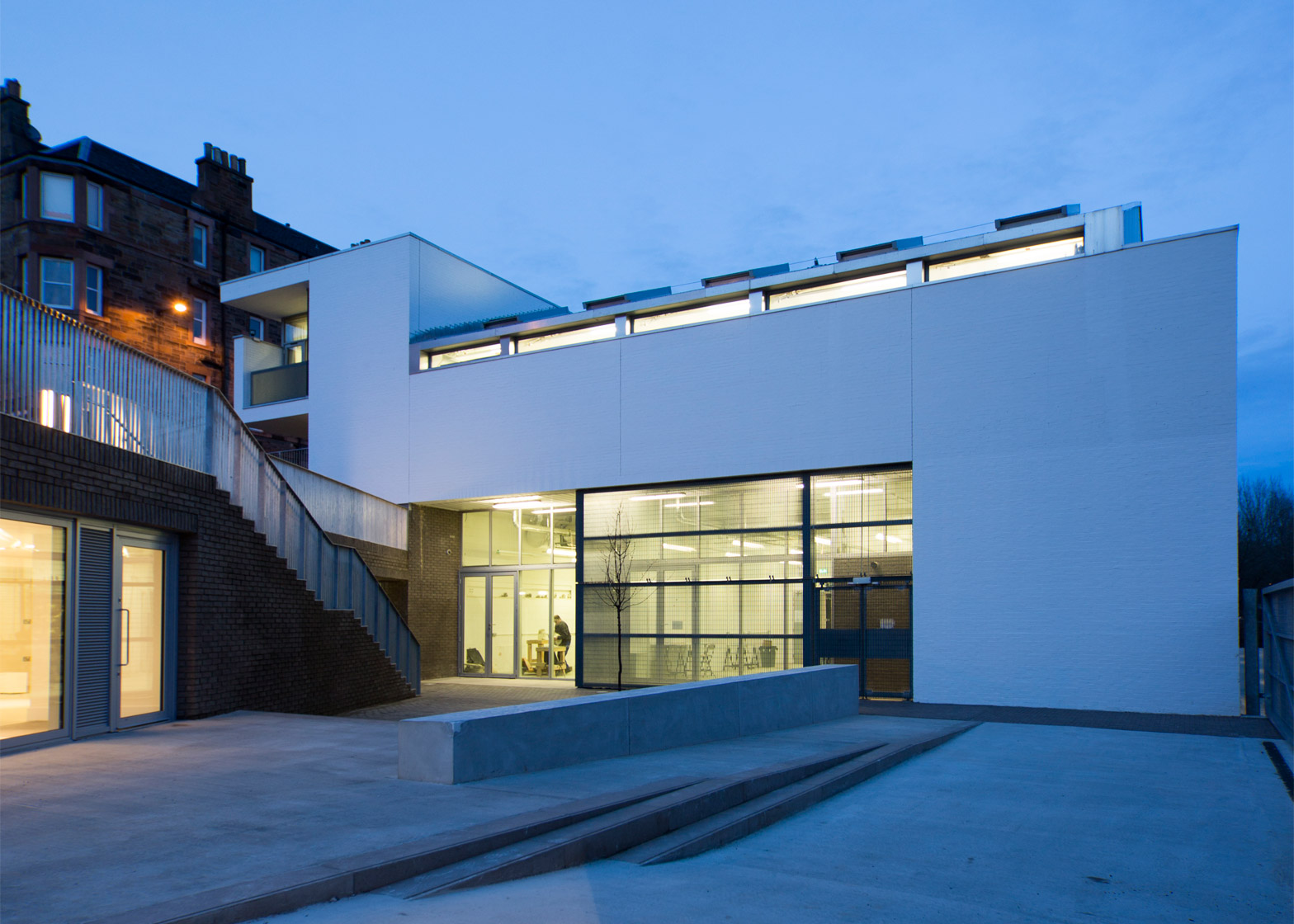A brick-clad tower provides a landmark for this sculpture workshop and cultural hub by Sutherland Hussey Harris, which is slotted into an old railway cutting in Edinburgh (+ slideshow).
Edinburgh Sculpture Workshop is a facility providing artists with low-cost studios, exhibition space and workshops in the Scottish capital's Newhaven area.
The centre was previously housed in an old railway shed but, following a fundraising campaign that secured contributions from various public bodies, local studio Sutherland Hussey Harris was commissioned to develop a facility better suited to the needs of the artists.
A second round of funding was provided by a private donation, enabling ESW to add a new building providing spaces for research and cross-disciplinary activities, as well the promotion of arts within the local community.
"The two phases represent an exploration into the opposite sides of the arts building coin," said the team. "One, the hermetic, practical, messy side of the making of art and [the other] the open, accessible and extrovert of the gallery."
A freestanding 28-metre-tall structure influenced by traditional bell towers or campaniles is intended to draw attention to the otherwise hidden facility.
"The ESW has international significance, yet their site provides little visibility," architect Sean Douglas told Dezeen. "This campanile is a kind of abstraction of a billboard, giving a bit of presence."
The first building, known as the Bill Scott Sculpture Centre, incorporates 30 artists studios and various additional amenities. Completed in 2012, it straddles the embankment of a disused railway next to the existing shed.
Workshops for wood, metal, plaster and mixed media are arranged around a covered courtyard. Rooms dedicated to educational and administrative functions are also included, alongside two self-serviced apartments for visiting lecturers and artists in residence.
The building's compact form and positioning within the railway cutting ensures the messy workshops at grade level are hidden from the adjacent street.
The workshops open onto the covered yard, which is lined with panels of steel grating that allow partial views of the surroundings.
The project's second phase resulted in the Creative Laboratories, which were completed in 2014. This building features a cloistered courtyard visible from the street, which is lined with bays where artworks can be displayed.
A pathway traverses the space between the Workshop and the Creative Laboratories, connecting the street with a cycle route that passes along the opposite side of the complex.
This area also accommodates a cafe that opens onto a terrace and the central courtyard, where events and exhibitions can take place.
Multipurpose rooms that can be used for producing or exhibiting work are situated at the end of the courtyard. The concrete bays also provide semi-open working areas and could be transformed into enclosed studios at a later date.
Primary structures in concrete clad with brick cladding were used throughout both phases of the project to ensure the buildings are robust and easy to maintain, whilst also referencing the area's industrial heritage.
The tower is illuminated from within at night, with the light emanating from a large aperture towards the top. The campanile also provides an alternative exhibition space that artists are invited to use for unique installations.
The first piece to be implemented earlier this year was a sound installation called Concrete Antenna. It combined recordings relating to the site's various histories that were played through speakers positioned within the tower.
Other studios featured on Dezeen include a concrete sanctuary for a painter that is half-submerged in a cliffside garden overlooking the Chilean coastline and an artist's cabin in rural Scotland that is covered in embossed zinc panels.
Photography is by Keith Hunter unless otherwise stated.
Project credits:
Client: Edinburgh Sculpture Workshop
Architects: Sutherland Hussey Harris
Project team: Charlie Sutherland, Charlie Hussey, Colin Harris, David McKenna, Sean Douglas
Project manager: Iain Logan, Thomson Bethune
Structural engineer: Colin Eastwood, David Narro Associates
Quantity surveyor: Alan Pinchard, Thomson Bethune
M&E engineer: Neil Granger & David Appleford, AECOM
Landscape architects: Liane Bauer and RankinFraser
CDMC: Ross Buchan, Thomson Bethune
Phase 1 main contractor: Graham Construction
Phase 2 main contractor: Maxi Construction







